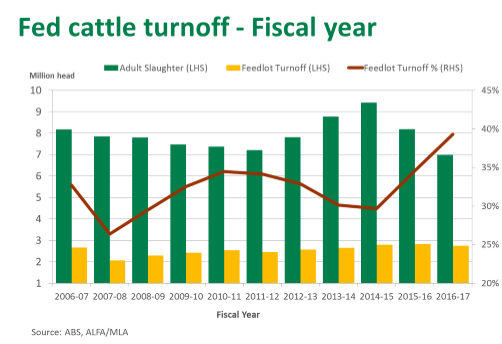Numbers on feed flourish
Cattle on feed at the end of the June 2017 quarter increased almost 73,000 head (or 7%) from the March quarter, to a record 1.09 million head, according to results from the latest ALFA/MLA lot feeding survey.
Record numbers of cattle placed on feed throughout the first half of the year was driven by historically high cattle prices, lower grain prices and deteriorating seasonal conditions across the eastern states.
Despite grain prices lifting in recent months, as deteriorating seasonal conditions have become a concern across many key grain producing countries, the impact on lot feeders has been partially mitigated by decreasing cattle prices.
Numbers on feed across all states increased 20% year-on-year:
- NSW increased 19% year-on-year, to 338,000 head
- Queensland advanced 22% year-on-year, to almost 627,000 head
- Victoria edged 1% higher year-on-year, to 64,000 head
- SA more than doubled year-on-year, to 34,000 head
- WA declined 16% year-on-year , to 26,000 head
There was a modest 3% decline in fed cattle turnoff in 2016-17, with feedlot operators incentivised to feed cattle for longer. As a percentage of total adult slaughter, however, it represents the highest fiscal year proportion on record, at 39%.

Underpinned by reduced cattle fed turnoff, Australian grainfed beef exports eased 4% year-on-year, at 258,000 tonnes shipped weight (swt). However, numbers on feed lifted in the second half of the year, supporting grainfed beef exports. In fact, 2016-17 grainfed beef exports were 14% above the five-year average.
- Shipments to Japan accounted for 52% of total Australian grainfed exports in 2016-17, at 129,000 tonnes swt – up 1% year-on-year
- Grainfed exports to Korea lifted 1% year-on-year, to 37,000 tonnes swt – 20% of total Australian grainfed exports
- Volumes of grainfed beef exported to China increased 11% year-on-year, to 26,500 tonnes swt, accounting for 10% of total grainfed exports



